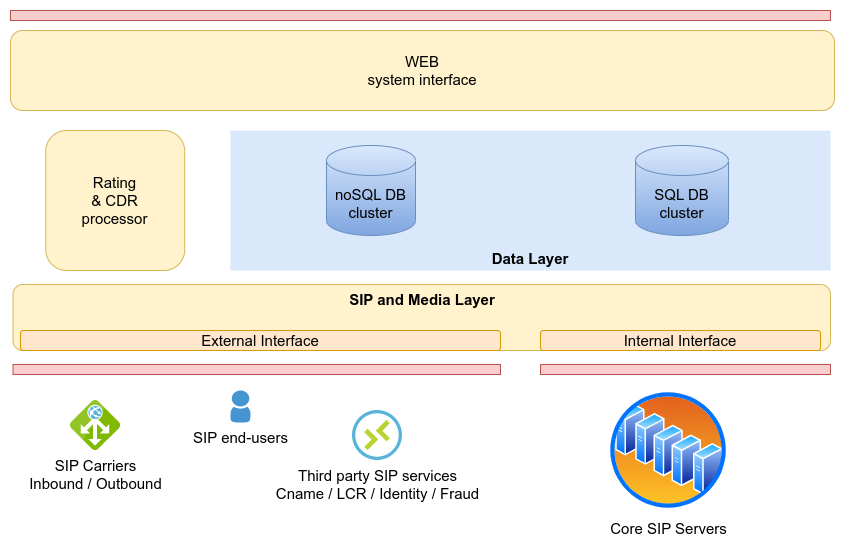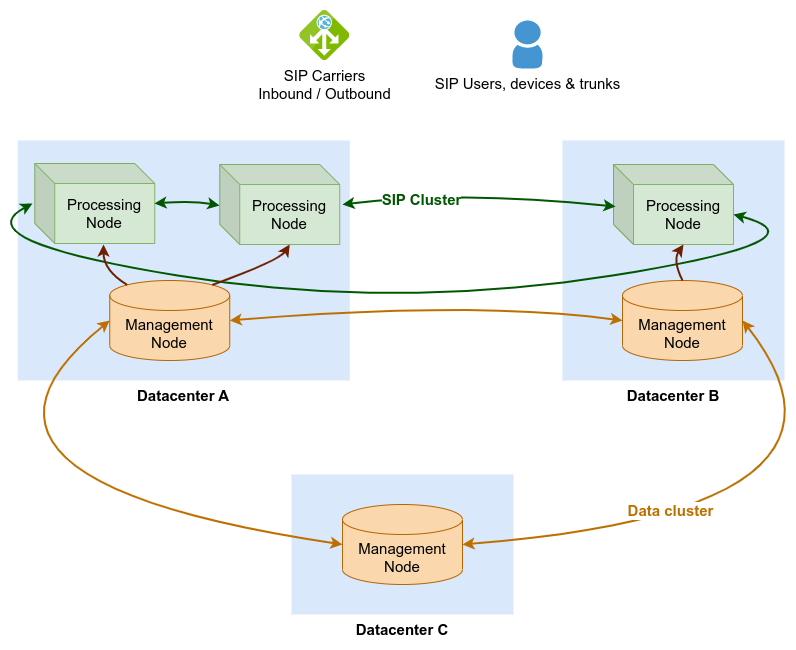
The Front-End SBC Engine
The SIPhub SBC is a SIP Engine to perform the role of a multi-purpose front-end for a core SIP systems (SIP servers, PBXes, gateways or Media Servers). The engine addresses to operators or carriers looking the secure and enhance the interaction of their core SIP system with the outer world - end users and PSTN carriers. The main purpose of the SBC is to control and balance the traffic to the core network elements. Nevertheless the SBC Engine is able to provide additional capabilities in relation to both the end-users and PSTN carriers.
The SBC Engine is a simple to operate component, via provisioning and monitoring WEB portals. This SBC Engine can be used for various purposes, like security, network consideration, core network balancing, end-user interaction or simple enhancing the service with border features.
This SBC Engine addresses various and complex needs related to Topology, SIP Routing, Security and SIP add-ons. It is designed for medium and large core systems, for handling both inbound and outbound traffic. The incorporated softwares and the internal design guarantee, in terms of concurrent-calls and calls-per-second, a high capacity solution able to geographically scale.
Architecture
A multi layer architecture makes the SIPhub SBC Engine easy to drive. Provisioning data is pushed top down via the Web Interface, controlling the SIP calling; as a result, events and data (like CDRs, analytics) are generated buttom up, being exposed in the Web Interface.

This architecture allows driving it in totally SIP agnostic mode, with a very simple way of inserting it into the existing SIP plaform, with minimum of changes of the other components.
SBC Engine Features
- Network level - IPv6 / IPv4 bridging
- Network level - handling NAT presence on end-user side
- Network level - running behind NAT or performing network bridging
- SIP transport level - UDP, TCP, TLS conversion
- SIP protocol level - Topology Hiding, Media pining, SIP interoperability
- SDP level - codec manipulation (filtering, reordering)
- Mid-registation (traffic optimization)
- High-Availability - active-backup HA for SBC itself
- Clustering (load and geographical) capabilities
- Routing and Load balancing of external traffic over several core components
- Failure detection and re-routing on core component failure
- Dial plan support for calling or caller parties
- Carrier Integration - origination, termination, DID support
- Carrier Integration - STIR/SHAKEN, LCR, CNAME
- Carrier Integration - SIP-I support
- Carrier Integration - external LNP (SIP redirect or REST)
- IP level: Flood detection (DOS)
- SIP level: SIP packet & dialog validation, registration validation
- Authentication: brute force attacks detection
- Traffic shaping: Calls per second, Parallel calls
- Access policies: per domain, per IP, per dialed number, black/white lists
- Fraud detection
- Presence enabling (BLF, end-2end, presence server)
- Trunk to registration conversion
- Instant Messaging
- CLI management
- CDR generation
- Call recording (SIPREC client)
- Call rating
- Audio Transcoding
- SIP traffic capturing
- Traffic analytics
SBC clustering
- Network level - IPv6 / IPv4 bridging
- Network level - handling NAT presence on end-user side
- Network level - running behind NAT or performing network bridging
- SIP transport level - UDP, TCP, TLS conversion
- SIP protocol level - Topology Hiding, Media pining, SIP interoperability
- SDP level - codec manipulation (filtering, reordering)
- Mid-registation (traffic optimization)
- High-Availability - active-backup HA for SBC itself
- Clustering (load and geographical) capabilities
- Routing and Load balancing of external traffic over several core components
- Failure detection and re-routing on core component failure
- Dial plan support for calling or caller parties
- Carrier Integration - origination, termination, DID support
- Carrier Integration - STIR/SHAKEN, LCR, CNAME
- Carrier Integration - SIP-I support
- Carrier Integration - external LNP (SIP redirect or REST)
- IP level: Flood detection (DOS)
- SIP level: SIP packet & dialog validation, registration validation
- Authentication: brute force attacks detection
- Traffic shaping: Calls per second, Parallel calls
- Access policies: per domain, per IP, per dialed number, black/white lists
- Fraud detection
- Presence enabling (BLF, end-2end, presence server)
- Trunk to registration conversion
- Instant Messaging
- CLI management
- CDR generation
- Call recording (SIPREC client)
- Call rating
- Audio Transcoding
- SIP traffic capturing
- Traffic analytics
The SBC Engine relies on a multi-node clustered architecture in order to achieve horizontal scalability and geographical distribution. There are two fundamental types of nodes, each forming separate clusters and independently scaling:
- Processing Node - nodes that do handle the SIP traffic / calls. Such nodes do consist of SIP and Media components, billing components and local databases
- Management Node - nodes responsible for data (provisioning, runtime and analytics) handling, consisting of the SQL/ noSQL databases, the provisioning WEB interface

- each Processing Node offers exactly the same service to any user in the system (full mesh, unique experience)
- each Processing Node may survive and provide service by itself (even if isolated)
- a Processing Node may still operate even if disconnected from it Management Node (offline mode)
- the Processing Nodes and Management Nodes may separately scale via different Datacenter's
Licensing
The license of the SIP Trunking Engine is per delivered instance, meaning:
- no per-user or per-channel limitations
- only initial cost, no recurrent costs
- it allows any number of nodes (in the clustered version)
- it allows your own changes and customizations
- gives access to the full source code
- the instance must not be copied, re-distributed or sold
